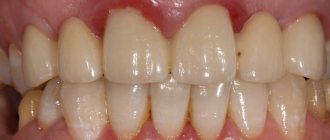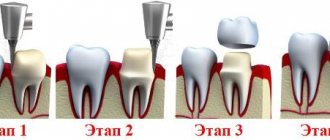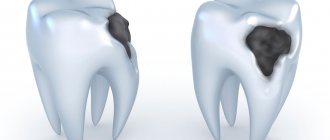Metal-ceramic crowns are a reliable, long-term way to restore teeth. Although cermet material is very durable, it is not eternal. The patient sometimes encounters cracks, abrasions, chips or scratches on the surface of the crown. Damage to ceramic cladding is caused by:
- High chewing load (too hard food);
- violation of the manufacturing technology of a crown or prosthesis;
- incompatibility of frame base and cladding materials;
- violation of installation technology (long prosthesis, incorrectly selected abutment teeth);
- bite problems;
- bruxism (teeth grinding).
Damage to the ceramic lining disrupts the aesthetics of the prosthetic structure and its functionality. But this is no reason to despair. The damaged surface can be restored, returning the crown to its original appearance. The main method of restoring a chipped crown without removing it is the restoration of metal ceramics with a light-curing composite.
Types of crowns
Metal-ceramic crowns differ in the metal alloy from which the frame is made, the manufacturing method, and service life. In most cases, an alloy of base metals (chromium-nickel, chromium-cobalt) is used to make the frame. They are durable, reliable, and not subject to deformation. This is a budget option that, with proper care, will last 8-10 years.
Often the frame is made of an alloy of gold with palladium, platinum, and silver. These are hypoallergenic materials that have an antibacterial effect, containing up to 80-90% gold. Ceramic-lined structures look natural, so they are perfect for installation in the smile area. Service life – up to 12-15 years.
When it comes to prosthetics on implants, the base of the crown is made of titanium. The material is compatible with body tissues, does not cause allergies, and eliminates the development of galvanic effect (galvanosis). Such structures will last 15 years or more.
According to manufacturing technology, metal-ceramic crowns can be cast or milled. Ceramic mass is applied layer by layer to the finished frame, made by any method, firing each subsequent layer. Modern dentistry has solved the problem of the “blue” strip around the gums, which made the installation of metal-ceramic structures on the front teeth undesirable. Today, crowns with shoulder mass are used - the manufacturing technology provides for a special ledge, which is also lined with ceramics to avoid oxidation of the metal upon contact with the gum. This makes the prosthesis aesthetic, allowing you to restore incisors and canines.
Can chipped dental crowns be repaired?
2 methods of crown restoration: which structures in principle need repair
One of the common problems that people who wear dentures face is damage to the dentures or a chipped crown. Typically, such defects appear on metal-ceramic models, so we will consider the reasons for such phenomena and options for repairing the prosthesis.
Material characteristics
Metal-ceramic columns are two-layer orthodontic structures, the frame of which is made of metal, and the front lining is made of ceramic. Typically, such dentures are used to restore a badly damaged tooth or if several need to be quickly restored. They are also used in the manufacture of bridge structures.
Metal-ceramic crowns are non-removable and therefore do not require special care and maintenance.
Causes of damage
Typically, chips on crowns occur infrequently. This prosthetic technology is one of the most reliable and durable, however, there are situations when damage does occur. There are several reasons:
- large chewing load. It usually occurs when eating solid foods;
- violation of the technology for installing or manufacturing a prosthesis;
- bruxism;
- incorrect prosthesis size;
- falling of a solid particle between the crown and tooth, etc.
In fact, even a medical error during impression taking and fitting can lead to the appearance of a defect.
However, metal-ceramic crowns can be repaired, which increases their service life and saves the owner from the need for replacement.
Methods of prosthesis restoration
Repair of metal-ceramic crowns is carried out using three different technologies, depending on the scale of the defect:
- Minor chips can be removed by polishing. It is important to note that as a result of processing, the structure may change shape, so this method of restoration is applicable only for dentures that are installed on distant teeth.
- Composite extension. This technology is the most common and allows you to restore even crowns with serious damage. Moreover, the structure is not removable. All manipulations are performed simply in the patient’s mouth.
In case of serious damage, the prosthesis is removed and simply replaced with a new one. In some cases, they resort to removing the structure to carry out repairs. However, this is an extreme measure, since it is not always possible to install it back.
Features of repair of zirconium crowns
This type of structure has been used in dental prosthetics relatively recently, and today they are the most durable and reliable in comparison with their analogues. It is virtually impossible for a zirconium crown to chip, eliminating the need for repairs.
Dental Health Predictions
Regardless of the technology for restoring a metal-ceramic crown, it is impossible to predict how long it will last. But it is quite possible to find out the approximate period of operation based on a number of signs:
- size of the lesion. If the chip is large or there are several damages, then the prosthesis will most likely collapse quickly, for this reason it is better not to waste time and money on restoration, but to immediately replace it;
- the basis. If it is made of metal, then it adheres to the composite worse than ceramics;
- bite. If it is incorrect, then this factor can again provoke a breakdown;
- non-compliance with recommendations for use and care;
- leaky connection, causing the structure to collapse.
Bridges with a large number of “teeth” are also at risk of breaking, so you should give preference to single dentures.
Restoration methods
Shallow cracks and abrasions are eliminated by polishing the ceramic surface. Small chips are restored using light-curing composites. This is the most common way to restore an orthopedic system without replacing it. Restoration of metal ceramics includes the following stages:
- The extension area is isolated from moisture;
- grind the chipped area to improve the adhesion of materials;
- after drying, a composite material is applied to the defect layer by layer, each layer is illuminated with a UV lamp;
- Upon completion of the extension, the area is ground and polished to give a natural shine, the appearance of a crown.
Repairing a metal-ceramic chip takes about 30 minutes. Restoration extends the life of the prosthesis, restores the original appearance, and returns the aesthetics and functionality of the dentition. However, repair of chips on metal ceramics is carried out without a guarantee, since there are many negative factors that affect the service life of the restoration.
If a metal-ceramic crown breaks off, there is no need to throw away the fragment. It is likely that the doctor will be able to use it to restore the integrity of the lining. In case of extensive damage, when a significant part of the metal is exposed, or chips of the lining of the contact surfaces, another option is required - replacing the damaged structure with a new one.
In what cases is restoration by installing a crown on a tooth indicated?
The procedure for installing a crown on a tooth has its own indications, including:
- Destruction of the crown part of the tooth by the carious process by more than 50%;
- Traumatic damage to a dental unit, in which its roots remain viable and are not damaged;
- Aesthetic defects that cannot be eliminated using other technologies: noticeable chips in the enamel, discoloration of the enamel coating, cracks.
A dentist may recommend installing temporary crowns for a patient with periodontitis: the procedure will help prevent further tooth loosening and prevent future tooth loss.
Restoration with crowns is contraindicated:
- For some blood pathologies;
- If you are allergic to local anesthetics;
- In the presence of chronic diseases of the body in the acute stage;
- In the presence of mental disorders.
Contraindications to the installation of crowns are identified during preparation for the prosthetic procedure and diagnostic studies.
How is a crown replaced?
Installation of a dental crown is a non-removable prosthetic method. This means that the patient cannot remove the structure on his own. This is done exclusively in a clinical setting. After the specialist has decided to replace the structure with a new one, in order to facilitate the removal of the damaged crown, it is carefully sawed or the cementing composition is destroyed with ultrasound. In this case, the crown can be removed without damaging it.
After removing the structure, the dentist assesses the condition of the supporting tooth and, if necessary, treats it. Upon completion of treatment and filling, repeated prosthetics are performed. That is, dental impressions are taken again, a prosthesis is made in the laboratory, and after fitting, the finished structure is fixed with cement.
The choice of material for a new dental crown depends on the clinical picture and the wishes of the patient. Often, when it is necessary to replace an old structure with a new one, the patient wants to improve the aesthetics by changing metal ceramics to solid ceramics or zirconium dioxide.
Restoration of metal ceramics after removal
Crown restoration is a complex job that requires professional skills. There is a serious risk of product destruction during removal. To perform this work you need special tools and devices.
If the broken fragment is preserved, it is fixed with medical glue. If there is no separated part, use the method of layer-by-layer application of the ceramic composition until the desired shape is obtained. The product is dried in a special oven using high temperature. Finally, turning and polishing are carried out. The method does not guarantee long-term use of the restored structure, even with high quality work performed.
Reviews
Most often, crowns are damaged after injury or due to improper dental care. Experts believe that it is necessary to restore chips as early as possible in order to avoid complete destruction of the product.
If you want to ask any questions about restoring the integrity of the crown or simply share your feedback, write them in the comments to this article.
Sources:
- https://www.adent.ru/vosstanovlenie-koronki-zuba
- https://pcvoice.ru/lechenie/restavraciya-koronok-zubah
- https://zubovv.ru/protezirovanie/nesemnyie-p/koronki-np/sposobyi-vosstanovleniya.html
- https://anZub.ru/protezirovanie/vosstanovlenie-koronkovojj-chasti-zuba/
- https://www.vash-dentist.ru/protezirovanie/nesemnyie-p/koronki-np/skol-keramiki-kak-ustranit-defekt.html
- https://medside.ru/shtiftyi-i-koronki
- https://www.tssdent.ru/vosstanovlenie-restavraciya-koronki/
A tooth has rotted under the crown: what to do?
If a tooth rots under the crown, then you need to keep in mind that this process is no longer reversible. It will continue until the tooth tissue on which the crown rests rots completely, after which the crown falls out (Fig. 4). Signs that the tooth is rotting are the following symptoms:
- bad smell from under the crown,
- food getting under the crown,
- root caries is visible at the lower edge of the crown,
- the tooth under the crown has turned black (if the crown is made of metal-free ceramics, then its darkening can serve as a symptom of carious damage to the tooth tissue under the crown).
Caries of the tooth root under the crown on an x-ray (Fig. 5-6) –
The best diagnosis of this process is to contact a dentist, who will be able to detect caries even on surfaces that are difficult to inspect. The onset of carious lesions on the root surface at the lower edge of the crown can be difficult to diagnose if caries occurs on the lateral surfaces of the tooth root, i.e. in the interdental space (24stoma.ru).
In the latter case, a targeted photograph of the tooth is taken (Fig. 5-6), in which caries under the crown looks like intense darkening, unusual for healthy tooth tissue. Keep in mind that early contact with the dentist in such a situation can sometimes allow the tooth to be treated and a new crown installed. Late treatment, on the contrary, brings you closer to tooth extraction.
Tooth rotting under the crown: video
Possible causes of pathology
Most often, tooth perforation is caused by incorrect manipulations by the doctor. Only in some cases does pathology develop against the background of other dental problems. The most common factors in the development of perforation include:
- Curved shape of root canals. When the canals are strongly curved, the process of tooth treatment becomes significantly more complicated. Narrowed and curved canals can be damaged if handled carelessly. A high risk of perforation is present during dental procedures aimed at eliminating infection that affects the internal dental tissues. Also, such a pathology often forms when the canals are greatly expanded or when preparing the tooth cavity for the installation of an inlay or pin.
- Injury to teeth. Mechanical impact on the dental cavity is one of the most common causes of perforation. Careless impact on tooth tissues with instruments can damage them, which leads to the subsequent formation of a hole. To exclude tooth perforation, you must carefully select a clinic and specialist.
- The result of caries complications. This perforation is caused by the destruction of the dental cavity by caries. Developing periodontitis not only causes perforation, but also leads to tooth loss.
Also, the risk of perforation of the tooth canal, its bottom or walls increases when the central dental axis is deviated from the norm. Perforation can be caused by severe abrasion of the chewing surface, thinning of the walls of the teeth, and dental procedures performed through an artificial crown.
Price
On average, the cost of restoring a chip on a metal-ceramic crown ranges from 2,500 to 4,500 rubles. Restoration using composite materials will cost approximately 3,000 rubles, and using solid inlays - from 4,000 rubles.
Re-polishing the restoration costs approximately 400 rubles, and making a new crown costs more than 10,000 rubles.
First of all, the price depends on the size and location of the damage. The qualifications of a specialist are of great importance. If the chip occurred as a result of an error by the dentist or dental technician, the patient does not pay for the repair.
The video presents a master class on intraoral repair of a prosthesis when the ceramic veneer is chipped.
Why does destruction occur?
Crowns can be destroyed for the following reasons:
- if the product was made of low-quality material;
- a person does not properly care for the oral cavity;
- in the presence of too heavy loads;
- if a person suffers from bruxism: teeth grinding.
How to extend the service life
After installing crowns, it is imperative to maintain oral hygiene. Brush your teeth at least 2 times a day, use floss, and purchase a toothpaste with a high degree of abrasiveness. Another mandatory requirement is to rinse your mouth after eating every time. And, of course, undergo regular inspections to ensure timely detection of damage. Thus, not only will your health be maintained, but time and money will also be saved.
In our dental clinic, doctors carefully select the material for making the crown and the design of the prosthesis. Thanks to the professionalism of the doctors, the crowns are installed in accordance with all requirements and fit tightly. It is violations of requirements and the lack of professionalism of some doctors that are a frequent reason for the destruction of the material. Therefore, you should choose only proven clinics for treatment.
Food gets under the crown: what to do
We have already said above that if there is an unpleasant odor from under the crown or food gets under the crown, these symptoms indicate the process of decay of the tooth tissue (carious tissue damage). No amount of rinsing or application can stop this process, and therefore, if you want to try to save the tooth, you need to urgently contact an orthopedic dentist.
It is only necessary to clarify that sometimes the smell from under the crown can be associated with the formation and suppuration of periodontal pockets. In this case, one of the symptoms may be redness of the gums around the crown, or there may be purulent discharge from periodontal pockets. It must be said that the formation of pockets near the crown occurs quite often, which can be associated both with prosthetic errors and due to poor oral hygiene.
What to pay attention to
If any problems arise, you should contact your dentist as soon as possible. We recommend coming for a consultation as soon as you notice:
- The appearance of an unpleasant putrid odor.
- It feels like something is stuck under the crown.
- Change in gum color, swelling, swelling, pain.
- The appearance of blood while brushing your teeth.
- Darkening of the abutment tooth.
When a tooth is prepared for a crown, the nerve endings are removed. Therefore, secondary caries passes painlessly. It can only be noticed by indirect signs. But these symptoms indicate that some pathological process is developing in the oral cavity. You should see a doctor immediately. Delaying a visit to the clinic will cause the inflammatory process to develop quickly.
Untreated inflammation under the crown is one of the most common causes of loss of an abutment tooth. A heavily damaged support unit cannot always be preserved. Most likely it will have to be removed and then re-prosthetics done.











